Resilience Thinking and Strategies to Reclaim Sustainable Rural Livelihoods: Cascade Tank-Village System (CTVS) in Sri Lanka
Abstract
1. Introduction
“Those who cannot remember the past are condemned to repeat it.”(George Santayana)
2. History and Development
3. Methodology: Combining Sustainable Livelihoods and Resilience Thinking
4. Applying SLF to Sri Lanka CTVS Context
“The significant problems we face cannot be solved at the same level of thinking we were at when we created them.”(Albert Einstein)
4.1. SLF Vulnerabilities
4.2. SLF Capitals Analysis
4.3. SLF Institutions and Processes
4.4. SLF Strategies
4.5. SLF Outcomes
4.6. SLF Overview
5. Social Ecological Perspective on Change
6. Results: Applied to Sri Lankan CTVS
7. Resilience Thinking Analysis
8. Conclusions
- As a restoration effort, the technical works, including desilting, ecological land-use restoration, dam construction, restoration, etc., are showing technical success. The resource units and users are under pressure from industrial agricultural practices, while there is exclusion of indigenous knowledge in farming production and markets;
- Ad-hoc infrastructure improvements and maintenance issues such as raising dams and spillways and desilting tanks, as well as destabilising the environment-social sensitivity in the whole system, have disrupted the hydrological balance in CTVSs;
- Social structure of rural life in the dry zone CTVs has been reduced to small-scale agricultural community life on fragmented resource units, which makes the more vulnerable to maintain their livelihoods and well-being;
- On the other hand, lack of access to mainstream markets, inadequate village level health, education, loss of environment-social sensitive knowledge system and other services, as well as labour shortages due to high demand of off-farm labour among the younger generation, are key challenges in the current socio-economic system;
- Finally, overlapping policies, institutional roles and responsibilities, as well as inefficiencies in state-led water management, failed to manage the whole system effectively and deliver expected results for better livelihoods
- The technology employed must be compatible with the present social-ecological conditions in the CTVS and its resilience, rather than limited to a recovery approach in restoration of the whole system;
- Collaborative governance arrangements, including community and other actors (polycentric governance), are essential for sustainable livelihoods, especially for fostering a sustainable multiple-use scenario of CTVS and its diversity maintenance;
- A potentially greater role for appropriate market linkages, as a key institution for cross-scale outcomes, including eco-tourism, of natural resource management opportunities, e.g., national park management and inclusive development [60].
- Increased productive diversity in non-farm activities with social-ecological conservation and regrowth will play a more important role in supporting secondary, linkage-dependent poverty-reducing growth, particularly in a situation where there are social-ecological-economic barriers to entry and high labour demands;
- Therefore, overall, one might conclude that a particular focus on a balance between restoration and transformation is required with a view to sustainable livelihoods
Author Contributions
Funding
Conflicts of Interest
References
- Jayanesa, H.A.H.; Selker, J.S. Thousand years of hydraulic civilization: Some sociotechnical aspects of water management. In Proceedings of the Workshop on Water and Politics: Understanding the Role of Politics in Water Management, Marseilles, France, 26–27 February 2004; Volume 2389156, pp. 225–237. [Google Scholar]
- Panabokke, C.R.; Sakthivadivel, R.; Dias Weerasinghe, A. Evolution, Present Status and Issues Concerning Small Tank Systems in Sri Lanka [Small Tanks in Sri Lanka: Evolution, Present Status and Issues]; International Water Management Institute (IWMI): Colombo, Sri Lanka, 2002. [Google Scholar]
- FAO. A Proposal for Declaration As a GIAHS: The Cascaded Tank-Village System (CTVS) in the Dry Zone of Sri Lanka. 2017. Available online: http://www.fao.org/giahs/giahsaroundtheworld/designated-sites/asia-and-the-pacific/the-cascaded-tank-village-system-ctvs-in-the-dry-zone-of-sri-lanka/en/ (accessed on 15 October 2020).
- IUCN. Restoring Traditional Cascading Tank Systems for Enhanced Rural Livelihoods and Environmental Services in Sri Lanka: Project Implementation Plan; IUCN, Sri Lanka Country Office: Colombo, Sri Lanka, 2015. [Google Scholar]
- Naidoo, K.; Thamaga-Chitja, J.; Shimelis, H. Towards sustainable livelihoods through indigenous knowledge and water use security: Insights from small scale irrigation schemes in Limpopo Province. Indilinga Afr. J. Indig. Knowl. Syst. 2013, 12, 301–324. [Google Scholar]
- Abeywardana, N.; Bebermeier, W.; Schütt, B. Ancient water management and governance in the dry zone of Sri Lanka until abandonment, and the influence of colonial politics during reclamation. Water 2018, 10, 1746. [Google Scholar] [CrossRef]
- Walker, B.; Salt, D. Resilience Practice: Building Capacity to Absorb Disturbance and Maintain Function; Island Press (World Resources Institute): Washington, DC, USA, 2012; ISBN 1610912314. [Google Scholar]
- Bandara, C.M.M. Catchment ecosystems and village tank cascades in the dry zone of Sri Lanka: A time-tested system of land and water resource management. In Strategies for River Basin Management; Lundqvist, J., Lohm, U., Falkenmark, M., Eds.; D. Reidel Publishing Company: Dordrecht, The Netherlands, 1985; pp. 99–113. [Google Scholar]
- Shannon, K.; Manawadu, S. Indigenous landscape urbanism: Sri Lanka’s reservoir & tank system. J. Landsc. Archit. 2007, 2, 6–17. [Google Scholar] [CrossRef]
- Bandara, C.M.M. Village Tank Cascade Systems of Sri Lanka: A Traditional Technology of Water and Drought Management. TIK 1985, 6, 328–336. [Google Scholar]
- Dharmasena, P.B. Tank-village system as a resource base for multi-purpose trees. In Proceedings of the 5th Regional Workshop on Multi-Purpose Trees, University of Peradeniya, Peradeniya, Sri Lanka, 1–3 April 1994; pp. 8–19. [Google Scholar]
- Murray, F.J. Potential for Aquaculture in Community-Managed Irrigation Systems of the Dry-Zone, Sri Lanka: Impacts on Livelihoods of the Poor. Ph.D. Thesis, Universty of Stirling, Stirling, UK, 2004. [Google Scholar]
- Gilliland, K.; Simpson, I.A.; Adderley, W.P.; Burbidge, C.I.; Cresswell, A.J.; Sanderson, D.C.W.; Coningham, R.A.E.; Manuel, M.; Strickland, K.; Gunawardhana, P.; et al. The dry tank: Development and disuse of water management infrastructure in the Anuradhapura hinterland, Sri Lanka. J. Archaeol. Sci. 2013, 40, 1012–1028. [Google Scholar] [CrossRef]
- Wijekoon, W.M.S.M.; Gunawardena, E.R.N.; Aheeyar, M.M.M. Institutional reforms in minor (village tank) irrigation sector of Sri Lanka towards sustainable development. In Proceedings of the 7th International Conference on Sustainble Built Environment, Kandy, Sri Lanka, 16–18 December 2016; p. 9. [Google Scholar]
- Kekulandala, B.; Jacobs, B.; Cunningham, R. Management of small irrigation tank cascade systems (STCS) in Sri Lanka: Past, present and future. Clim. Dev. 2020. [Google Scholar] [CrossRef]
- Köpke, S.; Withanachchi, S.S.; Pathiranage, R.; Withanachchi, C.R.; Ploeger, A. Social–ecological dynamics in irrigated agriculture in dry zone Sri Lanka: A political ecology. Sustain. Water Resour. Manag. 2019, 5, 629–637. [Google Scholar] [CrossRef]
- Simonsen, S.H.; Biggs, R.; Schlüter, M.; Schoon, M.; Bohensky, E.; Cundill, G.; Dakos, V.; Daw, T.; Kotschy, K.; Leitch, A.; et al. Applying Resilience Thinking: Seven Principles for Building Resilience in Social-Ecological Systems; Stockholm Resilience Centre: Stockholm, Sweden, 2014. [Google Scholar]
- Ostrom, E. Governing the Commons; Cambridge University Press: Cambridge, UK, 1990; ISBN 9781316423936. [Google Scholar]
- Ostrom, E. A general framework for analyzing sustainability of social-ecological systems. Source Sci. New Ser. 2009, 325, 419–422. [Google Scholar] [CrossRef]
- Hinkel, J.; Bots, P.W.G.; Schlüter, M. Enhancing the Ostrom social-ecological system framework through formalization. Ecol. Soc. 2014, 19, art51. [Google Scholar] [CrossRef]
- Moradet, S.; Merrey, D.; Seshoka, J.; Sally, H. Improving Irrigation Project Planning and Implementation Processes in Sub-Saharan Africa: Diagnosis and Recommendations; Final Report; International Water Management Institute: Colombo, Sri Lanka, 2005. [Google Scholar]
- Ashley, C.; Carney, D.; Britain, G. Sustainable Livelihoods: Lessons from Early Experience; DFID: London, UK, 1999. [Google Scholar]
- Chambers, R.; Conway, G.R. Sustainable Rural Livelihoods: Practical Concepts for the 21st Century; Overseas Development Institute (ODI): London, UK, 1991; Volume 296. [Google Scholar]
- Krantz, L. The Sustainable Livelihood Approach to Poverty Reduction; Swedish International Development Corporation Association (SIDA): Stockholm, Sweden, 2001; Available online: https://www.sida.se/English/publications/121288/the-sustainable-livelihood-approach-to-poverty-reduction/ (accessed on 15 October 2020).
- Ferrol-Schulte, D.; Wolff, M.; Ferse, S.; Glaser, M. Sustainable Livelihoods Approach in tropical coastal and marine social-ecological systems: A review. Mar. Policy 2013, 42, 253–258. [Google Scholar] [CrossRef]
- Dorward, A.; Poole, N.; Morrison, J.; Kydd, J.; Urey, I. Markets, institutions and technology: Missing links in livelihoods analysis. Dev. Policy Rev. 2003, 21, 319–332. [Google Scholar] [CrossRef]
- Holling, C.S. Understanding the complexity of economic, ecological, and social systems. Ecosystems 2001, 4, 390–405. [Google Scholar] [CrossRef]
- Dorward, A. Integrating contested aspirations, processes and policy: Development as hanging in, stepping up and stepping out. Dev. Policy Rev. 2009, 27, 131–146. [Google Scholar] [CrossRef]
- DFID. Sustainable Livelihoods Guidance Sheets; DFID: London, UK, 1999; ISBN 9783540331766. Available online: https://www.eldis.org/document/A41741 (accessed on 15 October 2020).
- Marzano, M. Rural livelihoods in Sri Lanka: An indication of poverty? J. Int. Dev. 2002, 14, 817–828. [Google Scholar] [CrossRef]
- Nayak, P.K. Fisher communities in transition: Understanding change from a livelihood perspective in Chilika Lagoon, India. Marit. Stud. 2017, 16, 16. [Google Scholar] [CrossRef]
- Gunderson, L.; Peterson, G.D.; Holling, C.S. Practicing adaptive management in complex social-ecological systems. In Complexity Theory for a Sustainable Future; Norberg, J., Cumming, G.S., Eds.; Columbia University Press: New York, NY, USA, 2008. [Google Scholar]
- Su, F.; Saikia, U.; Hay, I. Relationships between livelihood risks and livelihood capitals: A case study in Shiyang River Basin, China. Sustainability 2018, 10, 509. [Google Scholar] [CrossRef]
- Moser, C.; Anis, A.D. Assets, Livelihoods, and Social Policy; The International Bank for Reconstruction and Development/The World Bank: Washington DC, USA, 2008; ISBN 9789622098299. [Google Scholar]
- Batterbury, S. Sustainable Livelihoods: Still being sought, ten years on. In Proceedings of the Sustainable Livelihoods Framework: Ten Years of Researching the Poor African Environments Programme Workshop, Oxford, UK, 24 January 2008; Oxford University Centre for the Environment: Oxford, UK, 2008. [Google Scholar]
- Abeywardana, N.; Schütt, B.; Wagalawatta, T.; Bebermeier, W. Indigenous agricultural systems in the dry zone of Sri Lanka: Management transformation assessment and sustainability. Sustainability 2019, 11, 910. [Google Scholar] [CrossRef]
- Herath, K.; Dissanayake, S.; Vidanage, S.; Dharmasena, P.B.; Project, W.P. Livelihood impacts of village tank cascade restoration: An impact evaluation using a difference-indifference analysis. In Proceedings of the Food Security: Global Challenges and Prospects for the Nature, Colombo, Sri Lanka, 7 April 2019; Hector Kobbekaduwa Agrarian Research and Training Institute: Colombo, Sri Lanka, 2019. [Google Scholar]
- Scoones, I. Sustainable Rural Livelihoods and Rural Development; Fernwood Publiching and Practical Action Publishing: Rugby, UK, 2015; ISBN 978-185339-875-9. [Google Scholar]
- Horgan, F.G.; Kudavidanage, E.P. Use and avoidance of pesticides as responses by farmers to change impacts in rice ecosystems of southern Sri Lanka. Environ. Manag. 2020, 65, 787–803. [Google Scholar] [CrossRef]
- Jacobs, B.C.; Cordell, D.; Esham, M.; Dominish, E. Towards Phosphorus and Climate Smart Agriculture (PACSA) in Sri Lanka; Institute for Sustainable Futures, University of Technology Sydney (UTS): Sydney, Australia, 2017. [Google Scholar]
- De Alwis, C. Right effort for right Livelihood: Historical model of sustainable development from Sri Lanka. In Communication, Culture and Ecology: Rethinking Sustainable Development in Asia; Prasad, K., Ed.; Springer Nature Singapore PTE. LTD.: Singapore, 2018; pp. 37–50. ISBN 9789811071041. [Google Scholar]
- Awsadahami, U.B. Wawa (Tank), 3rd ed.; Prachee Publication: Colombo, Sri Lanka, 2015; ISBN 955-96820-0-8. [Google Scholar]
- Marambe, B.; Pushpakumara, G.; Silva, P. Biodiversity and agrobiodiversity in Sri Lanka: Village tank systems. In The Biodiversity Observation Network in the Asia-Pacific Region: Toward Further Development of Monitoring; Springer: Tokyo, Japan, 2012; pp. 403–430. [Google Scholar]
- Galappaththi, E.K.; Ford, J.D.; Bennett, E.M. Climate change and adaptation to social-ecological change: The case of indigenous people and culture-based fisheries in Sri Lanka. Clim. Change 2020, 1–22. [Google Scholar] [CrossRef]
- “Cyberlabe: Resilience—The Adaptive Cycle of Renewal” by Eric.Delcroix is Licensed with CC BY-NC-SA 2.0. To View a Copy of This License. Available online: https://creativecommons.org/licenses/by-nc-sa/2.0/ (accessed on 15 October 2020).
- Abeywardana, N.; Pitawala, A.; Schütt, B.; Bebermeier, W. Evolution of the dry zone water harvesting and management systems in Sri Lanka during the Anuradhapura Kingdom; a study based on ancient chronicles and lithic inscriptions. Water Hist. 2019, 11, 75–103. [Google Scholar] [CrossRef]
- Dharmasena, P.B. Sustainability of small tank irrigation systems in Sri Lanka at the 21st Century. In Traversing No Man’s Land: Interdisciplinary Essays in Honour of Sadurawan Madhuma Bandhura; Bandara, S.M., Ed.; Godage International Publishers: Colombo, Sri Lanka, 2009; pp. 233–252. [Google Scholar]
- Aheeyar, M. Alternative Approaches to Small Tank/Cascade Rehabilitation: Socio-Economic and Institutional Perspective; Research Report 162; Colombo, Hector Kobbekaduwa Agrarian Research and Training Institute: Colombo, Sri Lanka, 2013. [Google Scholar]
- Wijekoon, W.M.S.M.; Gunawardena, E.R.N.; Aheeyar, M.M.M.; De Silva, W.P.R.P. Resilience of farmers at water shortage situations in minor irrigation systems: A case study in Kurunegala District, Sri Lanka. Trop. Agric. Res. 2018, 29, 242. [Google Scholar] [CrossRef]
- Hardin, G. The tragedy of the commons. Science 1968, 162, 1243–1248. [Google Scholar] [CrossRef] [PubMed]
- Walker, B.H.; Abel, N.; Anderies, J.M.; Ryan, P. Resilience, adaptability, and transformability in the goulburn-broken catchment, Australia. Ecol. Soc. 2009, 14, 12. [Google Scholar] [CrossRef]
- Wickramasinghe, K. Ecotourism for Sustainable Management in Sri Lanka; Research Studies: Environmental Economic Policy Series; Institute of Policy Studies of Sri Lanka: Colombo, Sri Lanka, 2009. [Google Scholar]
- Author, I.; Mosse, D. Colonial and contemporary ideologies of “community management”: The case of tank irrigation development in South. Mod. Asian Stud. 1999, 33, 303–338. [Google Scholar]
- Biggs, R.; Schï, M.; Biggs, D.; Bohensky, E.L.; Burnsilver, S.; Cundill, G.; Dakos, V.; Daw, T.M.; Evans, L.S.; Kotschy, K.; et al. Toward Principles for Enhancing the Resilience of Ecosystem Services. Annu. Rev. Envrion. Resour. 2012, 37, 421–448. [Google Scholar] [CrossRef]
- Keen, M.; Brown, V.A.; Dyball, R. Social learning: A new approach to environmental management. In Social Learning in Environmental Management: Towards a Sustainable Future; Taylor & Francis Group: London, UK, 2012; pp. 1–21. ISBN 9781849772570. [Google Scholar]
- Berkes, F.; Ross, H. Panarchy and community resilience: Sustainability science and policy implications. Environ. Sci. Policy 2016, 61, 185–193. [Google Scholar] [CrossRef]
- García-Pérez, I.; Fernández-Izquierdo, M.Á.; Muñoz-Torres, M.J. Microfinance institutions fostering sustainable development by region. Sustainability 2020, 12, 2682. [Google Scholar] [CrossRef]
- Bandara, C.M.M. Small tank settlements in Sri Lanka. In Small Tank Cascade Systems: Their Relevance for Minor Irrigation Rehabilitation; Hector Kobbekaduwa Agrarian Research & Training Institute: Colombo, Sri Lanka, 2004; p. 76. [Google Scholar]
- Dharmasena, P.B. Cascaded tank-village system: Present status and prospects. In Agricultural Research for Sustainable Food Systems in Sri Lanka; Springer Nature Singapore PTE. LTD.: Singapore, 2020; Volume 1, pp. 63–75. [Google Scholar] [CrossRef]
- Kariyawasam, S.; Wilson, C.; Rathnayaka, L.I.M.; Sooriyagoda, K.G.; Managi, S. Conservation versus socio-economic sustainability: A case study of the Udawalawe National Park, Sri Lanka. Environ. Dev. 2020, 35, 100517. [Google Scholar] [CrossRef]
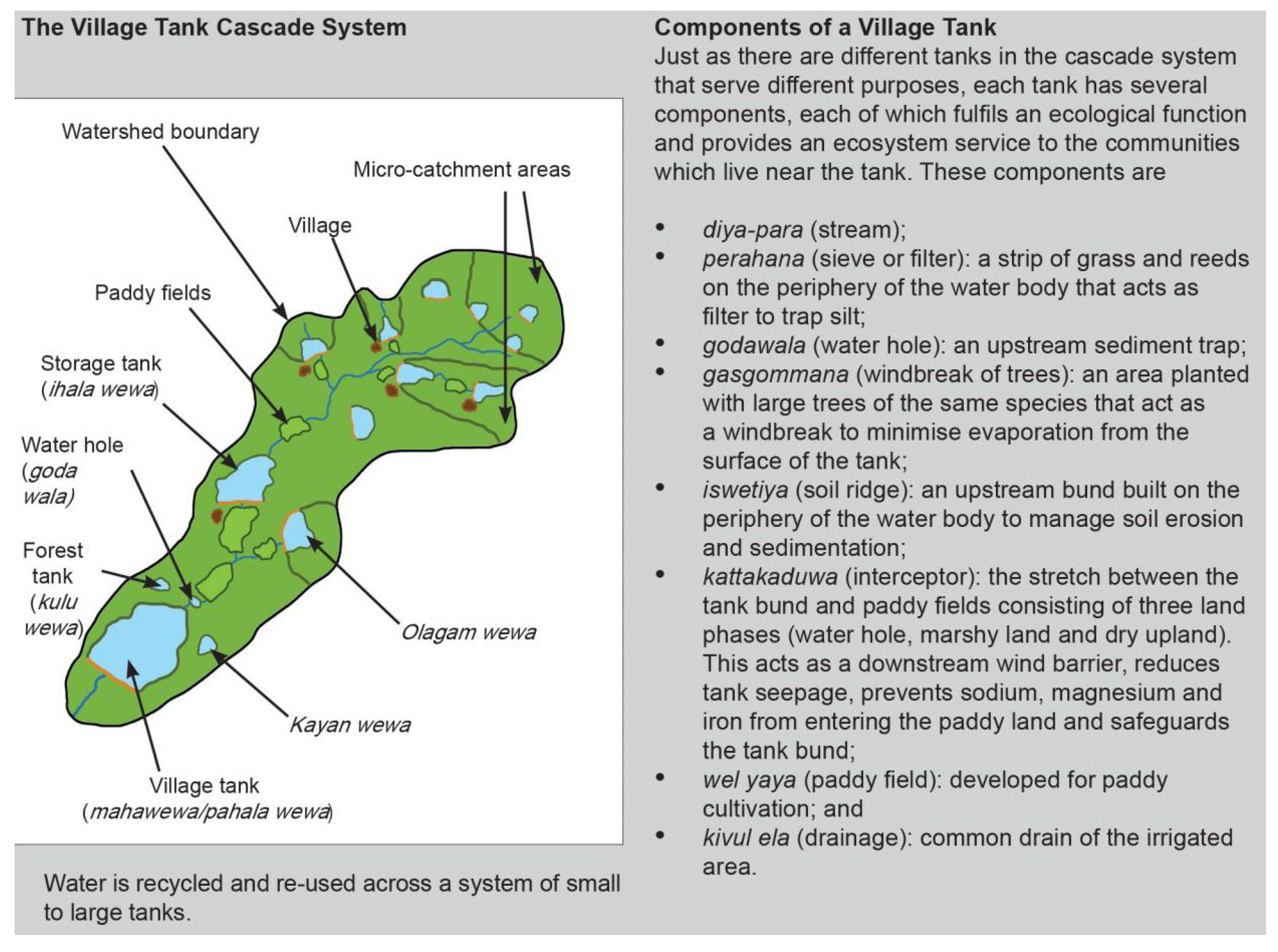
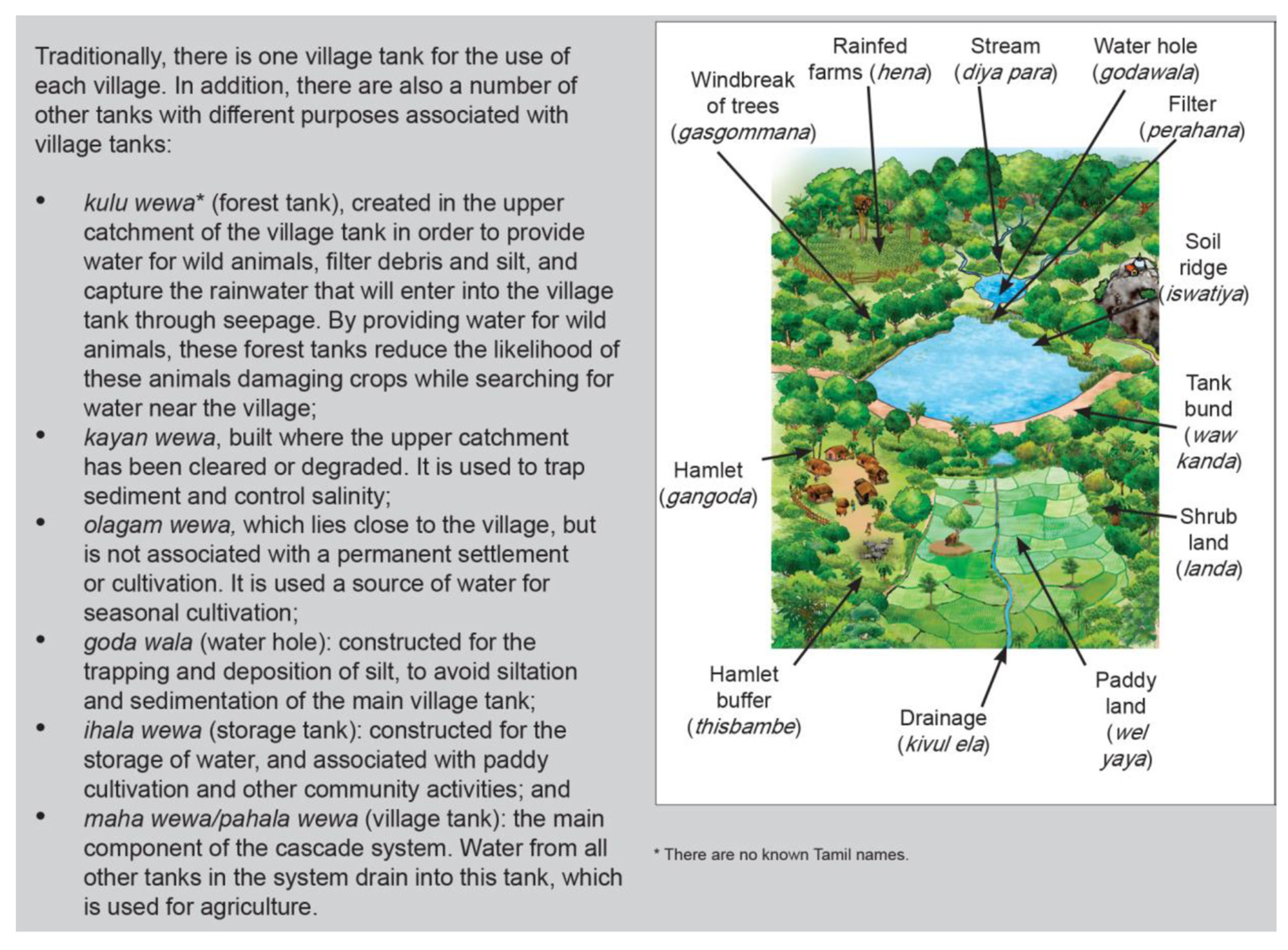
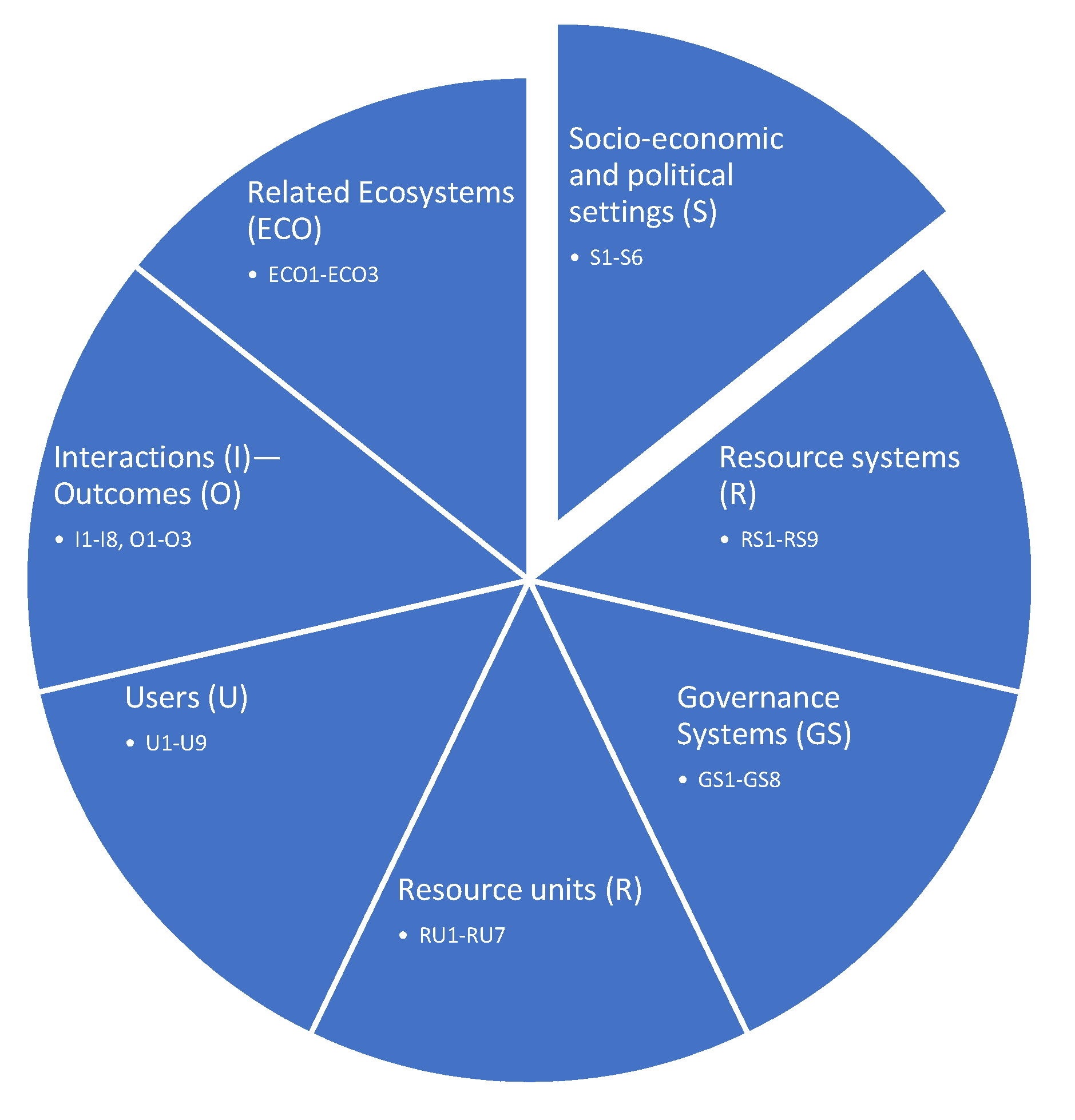
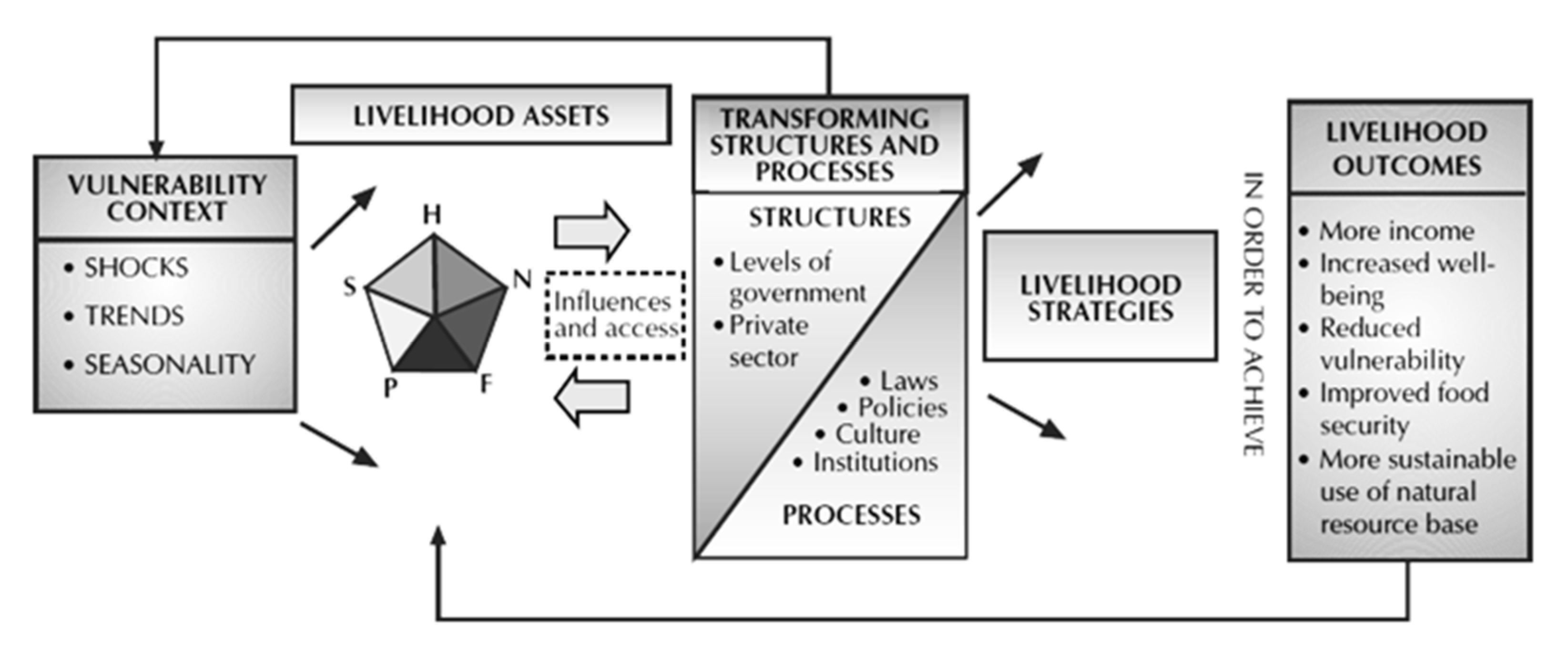
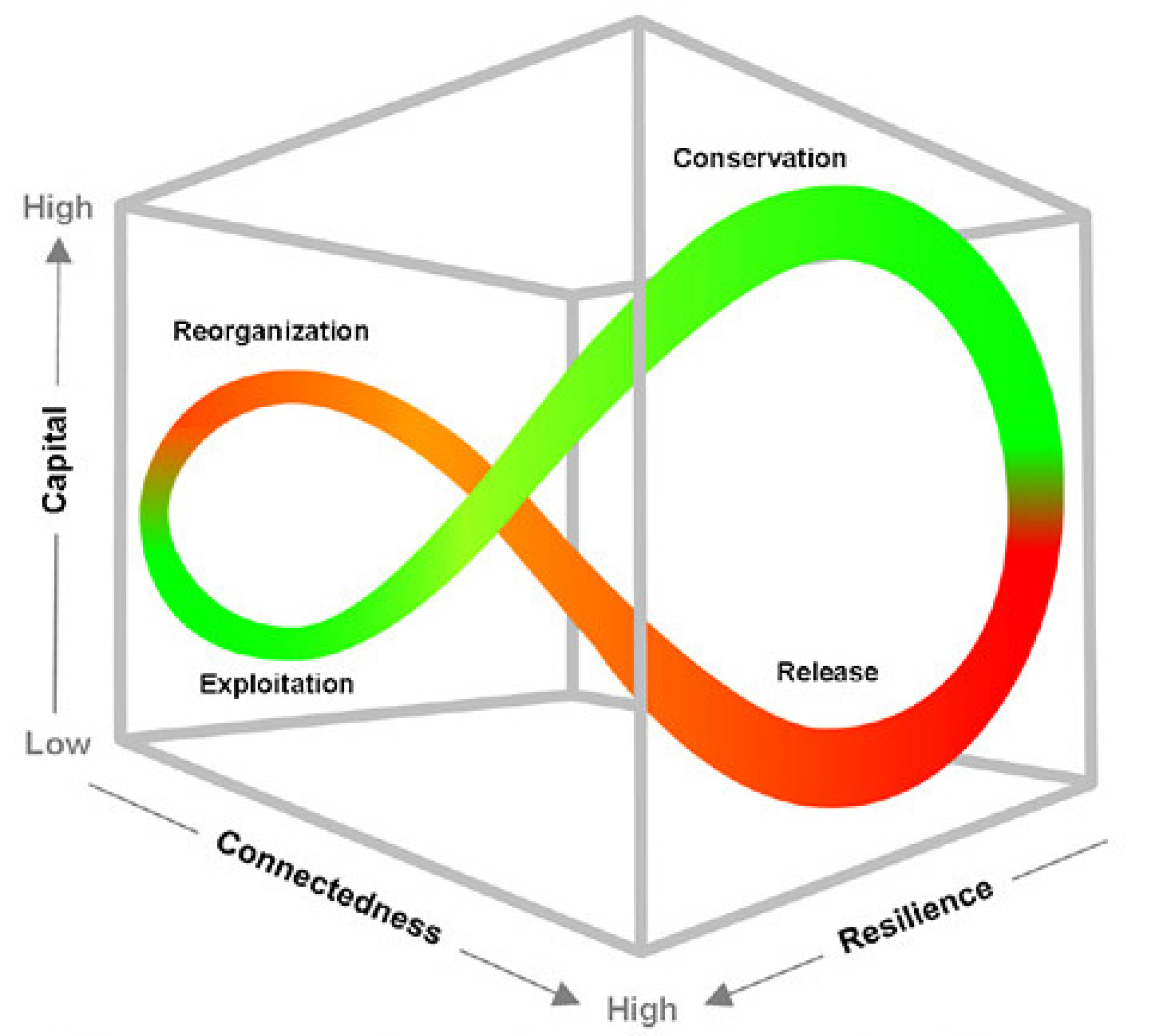
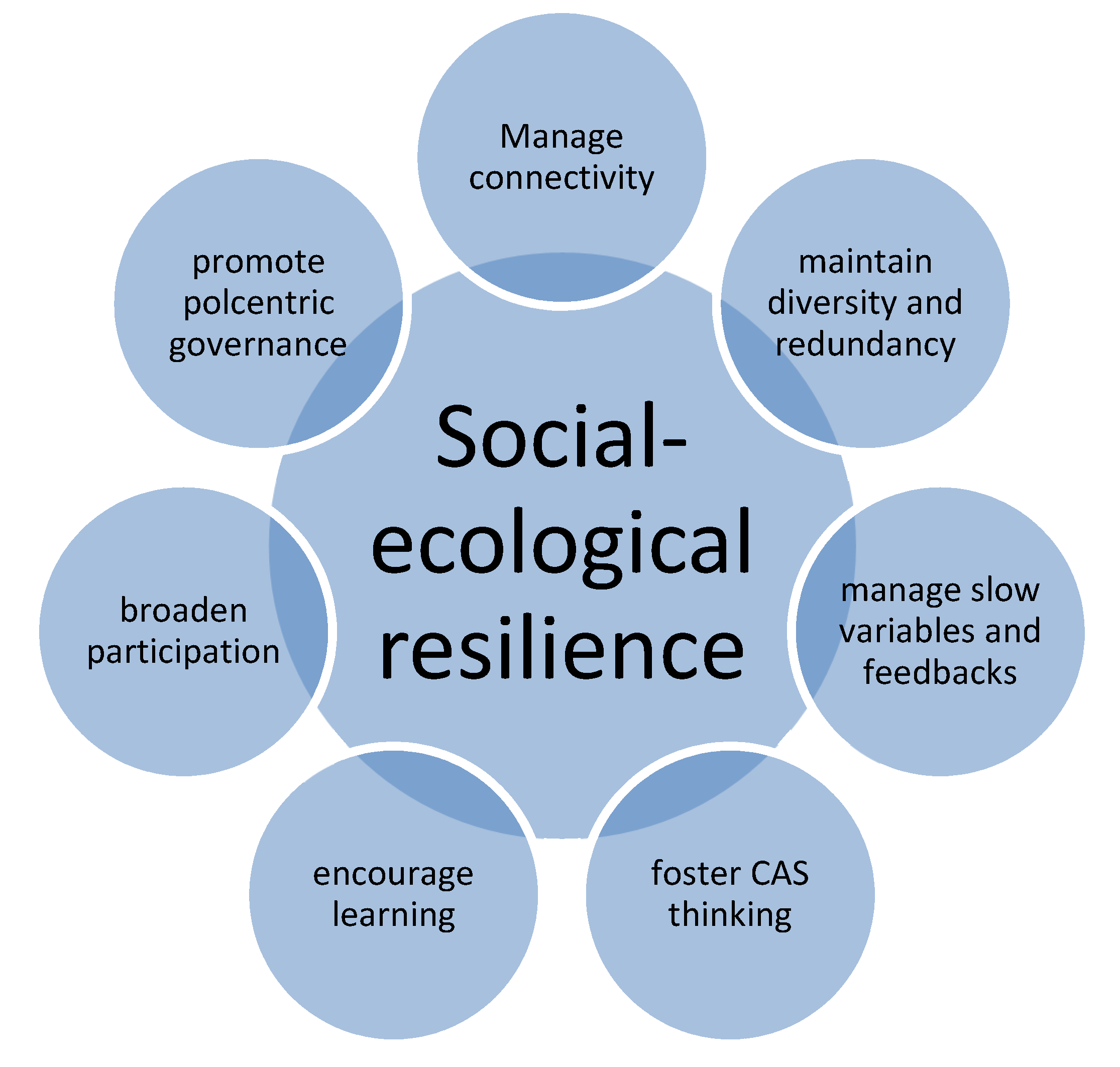
| Capitals | Level of Access | |
|---|---|---|
| Human [36,37] | Traditional agriculture skills and knowledge; Modern agriculture skills and knowledge; Indigenous knowledge in: medicine, art, industry, water management, food, livelihood and raw materials management Main labour from the older population including females | Traditional knowledge has not been transferred to youth labour/immediate generation due to various social, economic and political reasons. Youth labour limited to rural employment opportunities. |
| Social | Buddhist values and practices (Dharma) Farmer Organisation networks Funeral aid society Samurdihi (financial aid) society Rural development societies Food, labour and other resource sharing practice | Buddhist values and practices decrease throughout. Social networking and common interest of gathering become non-functional, due to spending more time on multiple employment jobs as the economic pressures increase. |
| Natural | High biodiversity—ecosystems such as wetlands, seasonally wet and drylands, paddy fields, uplands, forests, scrublands, tank beds, home gardens, rocky lands and water streams Land for livelihoods Natural multiple water sources Natural food sources, cottage materials, medicine, fuel, fertiliser, timber and water All year daylight and energy Livelihood animals (cow, water-buffalo) | Most of the common natural capitals are controlled and regulated by government authorities. Thus, the governance system creates access restrictions to use as well as in conservation. There are financial, knowledge and infrastructure deficiencies in the access and improvement of natural capitals in village livelihoods. |
| Physical | Major irrigation infrastructure The mix of restored and abandoned, high-density small tanks and water ponds distribution Traditional tools and equipment, and modern agricultural and related machinery Traditional small tank irrigation landscape | Water management and irrigation infrastructure management is active in most of the areas in the dry zone of Sri Lanka, but technical aspects and their sustainability have been criticised by many scholars as it leads to multiple issues in linked systems. While the farmer communities are often limited to traditional tools, the elite and business community have access to the majority of modern machinery. |
| Financial | Government subsidies, remittance programmes Government bank loan and credit schemes Samurdi programme (poverty alleviation financial scheme) | The common criticism is the inefficiency and gap of not meeting the needs of village communities relates to available financial capitals and poor coordination among institutions. |
Publisher’s Note: MDPI stays neutral with regard to jurisdictional claims in published maps and institutional affiliations. |
© 2020 by the authors. Licensee MDPI, Basel, Switzerland. This article is an open access article distributed under the terms and conditions of the Creative Commons Attribution (CC BY) license (http://creativecommons.org/licenses/by/4.0/).
Share and Cite
Melles, G.; Perera, E.D. Resilience Thinking and Strategies to Reclaim Sustainable Rural Livelihoods: Cascade Tank-Village System (CTVS) in Sri Lanka. Challenges 2020, 11, 27. https://doi.org/10.3390/challe11020027
Melles G, Perera ED. Resilience Thinking and Strategies to Reclaim Sustainable Rural Livelihoods: Cascade Tank-Village System (CTVS) in Sri Lanka. Challenges. 2020; 11(2):27. https://doi.org/10.3390/challe11020027
Chicago/Turabian StyleMelles, Gavin, and Ethmadalage Dineth Perera. 2020. "Resilience Thinking and Strategies to Reclaim Sustainable Rural Livelihoods: Cascade Tank-Village System (CTVS) in Sri Lanka" Challenges 11, no. 2: 27. https://doi.org/10.3390/challe11020027
APA StyleMelles, G., & Perera, E. D. (2020). Resilience Thinking and Strategies to Reclaim Sustainable Rural Livelihoods: Cascade Tank-Village System (CTVS) in Sri Lanka. Challenges, 11(2), 27. https://doi.org/10.3390/challe11020027






